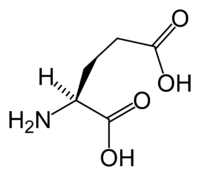
Photo from wikipedia
We examined effects of Group I metabotropic glutamate receptors on the excitability of mouse medial nucleus of the trapezoid body (MNTB) neurons. The selective agonist, S‐3,5‐dihydroxyphenylglycine (DHPG), evoked a dose‐dependent… Click to show full abstract
We examined effects of Group I metabotropic glutamate receptors on the excitability of mouse medial nucleus of the trapezoid body (MNTB) neurons. The selective agonist, S‐3,5‐dihydroxyphenylglycine (DHPG), evoked a dose‐dependent depolarization of the resting potential, increased membrane resistance, increased sag depolarization, and promoted rebound action potential firing. Under voltage‐clamp, DHPG evoked an inward current, referred to as IDHPG, which was developmentally stable through postnatal day P56. IDHPG had low temperature dependence in the range 25–34°C, consistent with a channel mechanism. However, the I‐V relationship took the form of an inverted U that did not reverse at the calculated Nernst potential for K+ or Cl−. Thus, it is likely that more than one ion type contributes to IDHPG and the mix may be voltage dependent. IDHPG was resistant to the Na+ channel blockers tetrodotoxin and amiloride, and to inhibitors of iGluR (CNQX and MK801). IDHPG was inhibited 21% by Ba2+ (500 μM), 60% by ZD7288 (100 μM) and 73% when the two antagonists were applied together, suggesting that KIR channels and HCN channels contribute to the current. Voltage clamp measurements of IH indicated a small (6%) increase in Gmax by DHPG with no change in the voltage dependence. DHPG reduced action potential rheobase and reduced the number of post‐synaptic AP failures during high frequency stimulation of the calyx of Held. Thus, activation of post‐synaptic Group I mGlu receptors modifies the excitability of MNTB neurons and contributes to the reliability of high frequency firing in this auditory relay nucleus.
Journal Title: Synapse
Year Published: 2019
Link to full text (if available)
Share on Social Media: Sign Up to like & get
recommendations!